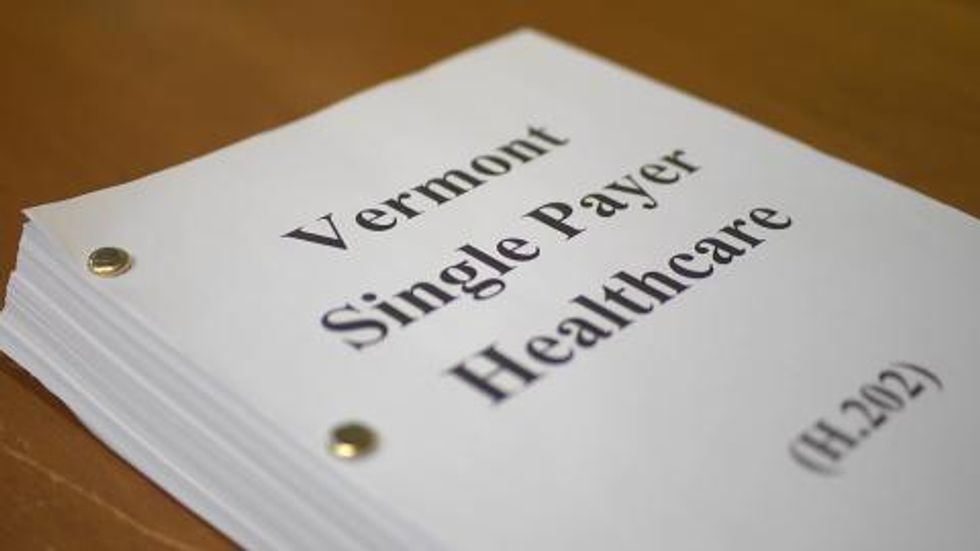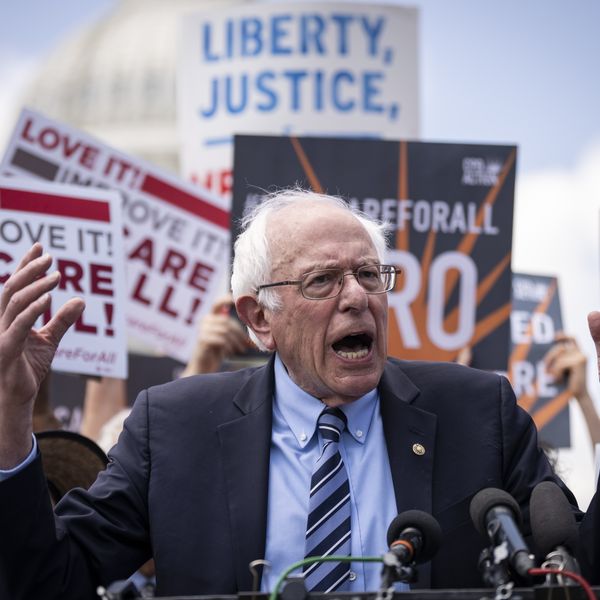Single Payer Is Not Dead
The prospects for single-payer health care -- adored by many liberals, despised by private health insurers and looking better all the time to others -- did not die in the Affordable Care Act. It was thrown a lifeline through a little-known provision tucked in the famously long legislation. Single-payer groups in several states are now lining up to make use of Section 1332.

Vermont is way ahead of the pack, but Hawaii, Oregon, New York, Washington, California, Colorado and Maryland have strong single-payer movements.
First, some definitions. Single-payer is a system where the government pays all medical bills. Canada has a single-payer system. By the way, Canada's system is not socialized medicine but socialized insurance (like Medicare). In Canada, the doctors work for themselves.
Under Section 1332, states may apply for "innovation waivers" starting in 2017. They would let states try paths to health care reform different from those mapped out by the Affordable Care Act -- as long as they meet certain of its goals. States must cover as many people and offer coverage as comprehensive and affordable. And they can't increase the federal deficit. Qualifying states would receive the same federal funding that would have been available under Obamacare.
My conservative friends complain that the innovation waiver requirements would rule out everything but single-payer. No doubt they are diligently working on a more privatized alternative that would cover less, cost more and raise the federal deficit.
"Vermont is the only state where they're thinking very concretely about using (the waiver) as part of their plan," Judy Solomon, health care expert at the Center on Budget and Policy Priorities, told me.
Hawaii got close. Its Legislature passed a single-payer bill in 2009, which was vetoed by then-Gov. Linda Lingle, a Republican. Lawmakers overrode the veto, but Lingle refused to implement the law.
The quest remains rocky, Dr. Stephen Kemble, a single-payer advocate and past president of the Hawaii Medical Association, told me. "If Vermont can get things going, that would make things easier for others."
In Washington State, "our focus is to work on grass-roots support," says Dr. David McLanahan, Washington coordinator for Physicians for a National Health Program. "We're laying the groundwork" for legislation and a request for an innovation waiver.
Problems in the Obamacare rollout have energized fans of single-payer. Computer glitches aside, the troubles stem chiefly from the law's complexity. Single-payer is all about simplicity.
Under the Vermont plan, employers and individuals would no longer have to buy private health coverage. They would instead pay a tax. The state-run system would also cover more things, like dental. And oh, yes, Vermonters could choose their hospitals and doctors.
William Hsiao, an economist at the Harvard School of Public Health, has projected that Vermont's annual health care spending could fall 25 percent. The savings would more than pay for the new benefits.
How? Fewer dollars would go to advertising, executive windfalls and payouts to investors. Doctors dealing with one insurer would save on office staff. Fraud and abuse would shrink as a comprehensive database makes crooks easier to spot.
It's too bad that some liberals have turned single-payer into a religion and are whacking the Vermont plan for not being pure enough. Vermont is permitting continued private coverage for very practical reasons.
Bear in mind that the most acclaimed health care systems -- in Germany, in France and our Medicare -- combine single-payer for basics with private coverage for the extras.
Vermont intends to use its state health insurance exchange as the structure on which to build its single-payer system. By 2017, the road to an innovation waiver should be clear.
Go forth, Green Mountain State. Show us what you can do.
An Urgent Message From Our Co-Founder
Dear Common Dreams reader, The U.S. is on a fast track to authoritarianism like nothing I've ever seen. Meanwhile, corporate news outlets are utterly capitulating to Trump, twisting their coverage to avoid drawing his ire while lining up to stuff cash in his pockets. That's why I believe that Common Dreams is doing the best and most consequential reporting that we've ever done. Our small but mighty team is a progressive reporting powerhouse, covering the news every day that the corporate media never will. Our mission has always been simple: To inform. To inspire. And to ignite change for the common good. Now here's the key piece that I want all our readers to understand: None of this would be possible without your financial support. That's not just some fundraising cliche. It's the absolute and literal truth. We don't accept corporate advertising and never will. We don't have a paywall because we don't think people should be blocked from critical news based on their ability to pay. Everything we do is funded by the donations of readers like you. Will you donate now to help power the nonprofit, independent reporting of Common Dreams? Thank you for being a vital member of our community. Together, we can keep independent journalism alive when it’s needed most. - Craig Brown, Co-founder |
The prospects for single-payer health care -- adored by many liberals, despised by private health insurers and looking better all the time to others -- did not die in the Affordable Care Act. It was thrown a lifeline through a little-known provision tucked in the famously long legislation. Single-payer groups in several states are now lining up to make use of Section 1332.

Vermont is way ahead of the pack, but Hawaii, Oregon, New York, Washington, California, Colorado and Maryland have strong single-payer movements.
First, some definitions. Single-payer is a system where the government pays all medical bills. Canada has a single-payer system. By the way, Canada's system is not socialized medicine but socialized insurance (like Medicare). In Canada, the doctors work for themselves.
Under Section 1332, states may apply for "innovation waivers" starting in 2017. They would let states try paths to health care reform different from those mapped out by the Affordable Care Act -- as long as they meet certain of its goals. States must cover as many people and offer coverage as comprehensive and affordable. And they can't increase the federal deficit. Qualifying states would receive the same federal funding that would have been available under Obamacare.
My conservative friends complain that the innovation waiver requirements would rule out everything but single-payer. No doubt they are diligently working on a more privatized alternative that would cover less, cost more and raise the federal deficit.
"Vermont is the only state where they're thinking very concretely about using (the waiver) as part of their plan," Judy Solomon, health care expert at the Center on Budget and Policy Priorities, told me.
Hawaii got close. Its Legislature passed a single-payer bill in 2009, which was vetoed by then-Gov. Linda Lingle, a Republican. Lawmakers overrode the veto, but Lingle refused to implement the law.
The quest remains rocky, Dr. Stephen Kemble, a single-payer advocate and past president of the Hawaii Medical Association, told me. "If Vermont can get things going, that would make things easier for others."
In Washington State, "our focus is to work on grass-roots support," says Dr. David McLanahan, Washington coordinator for Physicians for a National Health Program. "We're laying the groundwork" for legislation and a request for an innovation waiver.
Problems in the Obamacare rollout have energized fans of single-payer. Computer glitches aside, the troubles stem chiefly from the law's complexity. Single-payer is all about simplicity.
Under the Vermont plan, employers and individuals would no longer have to buy private health coverage. They would instead pay a tax. The state-run system would also cover more things, like dental. And oh, yes, Vermonters could choose their hospitals and doctors.
William Hsiao, an economist at the Harvard School of Public Health, has projected that Vermont's annual health care spending could fall 25 percent. The savings would more than pay for the new benefits.
How? Fewer dollars would go to advertising, executive windfalls and payouts to investors. Doctors dealing with one insurer would save on office staff. Fraud and abuse would shrink as a comprehensive database makes crooks easier to spot.
It's too bad that some liberals have turned single-payer into a religion and are whacking the Vermont plan for not being pure enough. Vermont is permitting continued private coverage for very practical reasons.
Bear in mind that the most acclaimed health care systems -- in Germany, in France and our Medicare -- combine single-payer for basics with private coverage for the extras.
Vermont intends to use its state health insurance exchange as the structure on which to build its single-payer system. By 2017, the road to an innovation waiver should be clear.
Go forth, Green Mountain State. Show us what you can do.
The prospects for single-payer health care -- adored by many liberals, despised by private health insurers and looking better all the time to others -- did not die in the Affordable Care Act. It was thrown a lifeline through a little-known provision tucked in the famously long legislation. Single-payer groups in several states are now lining up to make use of Section 1332.

Vermont is way ahead of the pack, but Hawaii, Oregon, New York, Washington, California, Colorado and Maryland have strong single-payer movements.
First, some definitions. Single-payer is a system where the government pays all medical bills. Canada has a single-payer system. By the way, Canada's system is not socialized medicine but socialized insurance (like Medicare). In Canada, the doctors work for themselves.
Under Section 1332, states may apply for "innovation waivers" starting in 2017. They would let states try paths to health care reform different from those mapped out by the Affordable Care Act -- as long as they meet certain of its goals. States must cover as many people and offer coverage as comprehensive and affordable. And they can't increase the federal deficit. Qualifying states would receive the same federal funding that would have been available under Obamacare.
My conservative friends complain that the innovation waiver requirements would rule out everything but single-payer. No doubt they are diligently working on a more privatized alternative that would cover less, cost more and raise the federal deficit.
"Vermont is the only state where they're thinking very concretely about using (the waiver) as part of their plan," Judy Solomon, health care expert at the Center on Budget and Policy Priorities, told me.
Hawaii got close. Its Legislature passed a single-payer bill in 2009, which was vetoed by then-Gov. Linda Lingle, a Republican. Lawmakers overrode the veto, but Lingle refused to implement the law.
The quest remains rocky, Dr. Stephen Kemble, a single-payer advocate and past president of the Hawaii Medical Association, told me. "If Vermont can get things going, that would make things easier for others."
In Washington State, "our focus is to work on grass-roots support," says Dr. David McLanahan, Washington coordinator for Physicians for a National Health Program. "We're laying the groundwork" for legislation and a request for an innovation waiver.
Problems in the Obamacare rollout have energized fans of single-payer. Computer glitches aside, the troubles stem chiefly from the law's complexity. Single-payer is all about simplicity.
Under the Vermont plan, employers and individuals would no longer have to buy private health coverage. They would instead pay a tax. The state-run system would also cover more things, like dental. And oh, yes, Vermonters could choose their hospitals and doctors.
William Hsiao, an economist at the Harvard School of Public Health, has projected that Vermont's annual health care spending could fall 25 percent. The savings would more than pay for the new benefits.
How? Fewer dollars would go to advertising, executive windfalls and payouts to investors. Doctors dealing with one insurer would save on office staff. Fraud and abuse would shrink as a comprehensive database makes crooks easier to spot.
It's too bad that some liberals have turned single-payer into a religion and are whacking the Vermont plan for not being pure enough. Vermont is permitting continued private coverage for very practical reasons.
Bear in mind that the most acclaimed health care systems -- in Germany, in France and our Medicare -- combine single-payer for basics with private coverage for the extras.
Vermont intends to use its state health insurance exchange as the structure on which to build its single-payer system. By 2017, the road to an innovation waiver should be clear.
Go forth, Green Mountain State. Show us what you can do.

